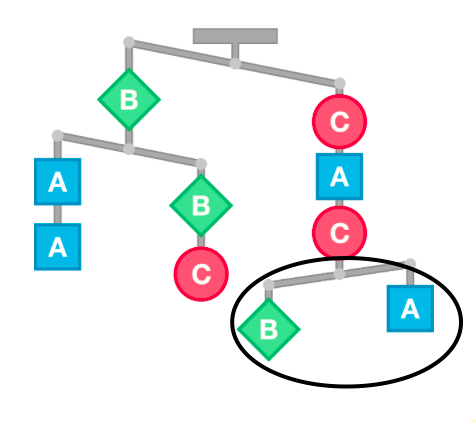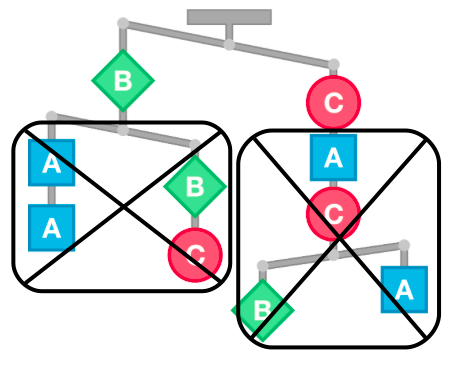Order those Weights.
Order the shapes from lightest to heaviest.
This section requires Javascript.
You are seeing this because something didn't load right. We suggest you, (a) try
refreshing the page, (b) enabling javascript if it is disabled on your browser and,
finally, (c)
loading the
non-javascript version of this page
. We're sorry about the hassle.
10 solutions
Doesn't necessarily mean that C > B. But if you count left and right you will see there's 1 B more left and 1 C more right(next to the 2 A's, 1B and 1 C om both sides). Hence B<C.
Note: there is one more inequality that can be written 2 A < B + C but nothing can be deduced about C from it.
That's not enough. So far you've only proved that B > A. There's more than that.
Log in to reply
The top balance indicates that
2 A + 2 B + C 2 A + 2 B + C 2 B − B ⟹ B < 2 A + B + 2 C < 2 A + B + 2 C < 2 C − C < C
My solution is totally pictorial. First,
A
<
B
:

Then, let's remove
2
A
,
B
and
C
from both sides:

So, B < C
Finally, combining both pictures we get A < B < C
Draw a bit bettar!!!!!!
Log in to reply
I have tried now. Hope it's a bit better! :)
it's a very elegant proof!
Can you really do it this way? For example, the two C:s are not on the same distance from the center of the balance.
Log in to reply
Without actually being told we are assuming that the weights are equal distances on each side (otherwise you can't really solve the problem). Therefore each set of weights is acting the same distance from center (it doesn't matter where they are positioned on the lower bars, the lower weights are all acting on the same point of the upper bar).
I just assume that removing same things from different sides of the balance doesn't change the equilibrium.
Log in to reply
It doesn't, as long as they are acting at the same distance from center.
Log in to reply
@Chris Cheek – I see, you're right. We only have to assume that the sides of the upper bar are equally length. As you described below.
A very elegant proof.
In the lower right corner of the picture, it shows 1 A weighed against 1 B. Since the B is lower, A < B. Both sides of the overall balance have 2 A's, and at least 1 B and C. However, the left side has an additional B, and the right side has an additional C. The C side is lower, so B < C. In the end, it's A < B < C.
Clean reasoning indeed
Lol I'm 11 and did a quiz and got all right I'm smart
This diagrams depicts that 2A + 2B + C < 2A + B + 2C. We can simplify this to B < C. The scale on the bottom of the right side of the big scale shows that A < B. Therefore, A<B<C.
B > A
2A + B +2C > 2A + 2B + C
2A - 2A + 2C - C > 2B - B
C > B
Therefore: C > B > A
Conclusion from the right end : B bigger than A And when solve the hall system which is ( right) 2c+2a+b > 2a+ 2b+c ( left) Result : c> b and already known b>a Total : c>b>a
Well I got the answer in a bit different way. Firstly, look at the last balance in the left side where there are two As against a B and a C combined. From this, we can say that 2A<B+C (or) A<(B+C)/2 This means that A is even lighter than the mean of the other two blocks. So one can make a guess that A is the lightest. This can even be confirmed by looking at the last balance of the right side where clearly B is more heavier than A. So for the time being we can write. A<B Now in the main balance, there are two Bs in the left side and 2 Cs in the right side and we can see that the right side is more dominating the left side. This means that C>B. And from our last two expressions we get that A is the least heaviest of all. So, A<B<C.
1.B>A 2.2A+2C+B>2B+2A+C :- 2C+B>2B+C :-C>B THEREFORE- A<B<C
A < B,
2A + 2B + C < 2A + B + 2C
2A - 2A + 2B - B < 2C - C
B < C
So, A < B < C
I have a question!!!! who can tell me why the A and B in bottom of the right side can keep balance. their weights are different, but the distance to the fulcrum are the same(no matter the lever has been tilted or not). that's means their moments are different. So how can the leverage keep balance???
Relevant wiki: Linear Inequalities Word Problems
The right bottom balance indicates that A < B .
The top balance indicates that
2 A + 2 B + C 2 A + 2 B + C 2 B − B ⟹ B < 2 A + B + 2 C < 2 A + B + 2 C < 2 C − C < C
Therefore, A < B < C .